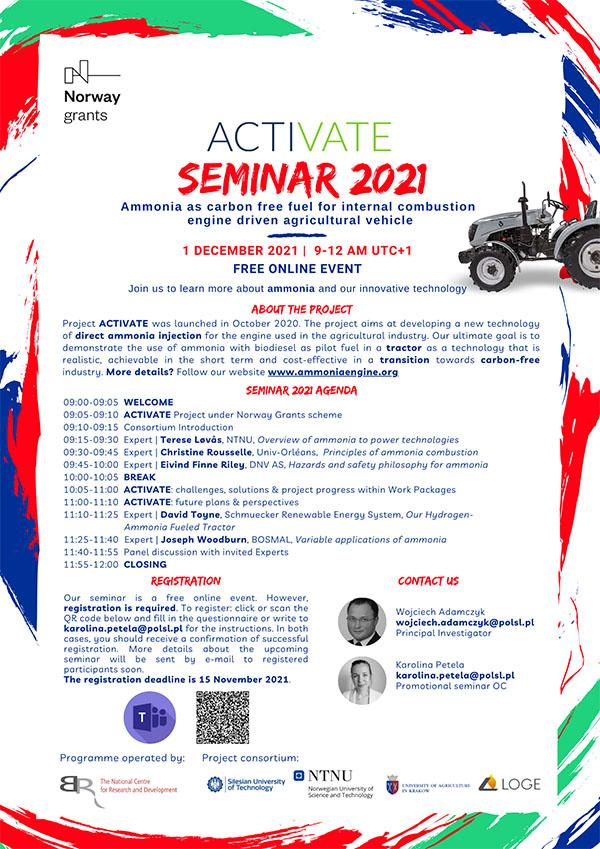News - ComKin
New PhD 2022
The ComKin group welcomes PhD candidate Krister Aaen Pedersen. Krister’s PhD work will be on detailed chemical kinetics related to ammonia combustion in internal combustion engines, building upon the numerical and experimental work being performed by the group.”
Recent publication in Transportation Engineering
Numerical investigation of optimal flow conditions in an optically accessed compression ignition engine
Micha ł T. Lewandowski ∗ , Corinna Netzer , David R. Emberson , Terese Løvås
Abstract
This study aims towards quantifying of the flow in an optically accessed compression ignition engine using computational fluid dynamic simulations. The test rig serves to investigate different fuels and allows for spray propagation observation and in-flame soot measurements. Computational fluid dynamic simulations were employed to investigate the effects of geometrical modifications in order to obtain optimal flow conditions for fuel spray injection. The flow should be quiescent enough to avoid affecting spray propagation but effectively remove flue gasses after combustion and prevent glass fouling to allow optical observations. The numerical model results are validated against experimental data for several conditions. Different turbulence Reynolds Averaged Navier Stokes (RANS) closures were assessed and briefly discussed. Three geometrical configurations of the connecting throat have been employed and the resulting flow was analyzed under motored conditions revealing favourable conditions for fuel spray injection. Finally, non-reacting, evaporating spray simulations in those configurations have been performed showing the impact of the gas flow in the combustion chamber on spray propagation.
Recent publication in Ultrasonics Sonochemistry
Does power ultrasound (26 kHz) affect the hydrogen evolution reaction (HER) on Pt polycrystalline electrode in a mild acidic electrolyte?
Bruno G.PolletaFaranakForoughiaAlaa Y.FaidbDavid R.EmbersoncMd.H.Islama
Abstract
In this study, we investigated the effects of power ultrasound (26 kHz, up to ∼75 W/cm2, up to 100% acoustic amplitude, ultrasonic horn) on the hydrogen evolution reaction (HER) on a platinum (Pt) polycrystalline disc electrode in 0.5 M H2SO4 by cyclic and linear sweep voltammetry at 298 K. We also studied the formation of molecular hydrogen (H2) bubbles on a Pt wire in the absence and presence of power ultrasound using ultra-fast camera imaging. It was found that ultrasound significantly increases currents towards the HER i.e. a ∼250% increase in current density was achieved at maximum ultrasonic power. The potential at a current density of −10 mA/cm2 under silent conditions was found to be −46 mV and decreased to −27 mV at 100% acoustic amplitude i.e. a ΔE shift of ∼+20 mV, indicating the influence of ultrasound on improving the HER activity. A nearly 100% increase in the exchange current density (jo) and a 30% decrease in the Tafel slope (b) at maximum ultrasonic power, was observed in the low overpotential region, although in the high overpotential region, the Tafel slopes (b) were not significantly affected when compared to silent conditions. In our conditions, ultrasound did not greatly affect the “real” surface area (Ar) and roughness factor (R) i.e. the microscopic surface area available for electron transfer. Overall, it was found that ultrasound did not dramatically change the mechanism of HER but instead, increased currents at the Pt surface area through effective hydrogen bubble removal.
Recent publication in Fuel
Generalised Eddy Dissipation Concept for MILD combustion regime at low local Reynolds and Damköhler numbers. Part 2: Validation of the model
Michał T.LewandowskiabZhiyiLicAlessandroParentecdJacekPozorskia
Abstract
The generalised Eddy Dissipation Concept (EDC) developed in the first part of this article is thoroughly validated against twelve flames from the Delft and Adelaide jet-in-hot-coflow (JHC) burners. These flames emulate Moderate or Intense Low Oxygen Dilution (MILD) conditions. Modelling of turbulence-chemistry interactions in this regime is a non trivial problem and many standard combustion models may fail. Recent Direct Numerical Simulation studies revealed a distributed appearance of the reaction zone indicating non-flamelet regime, which justified the use of reactor type modelling approaches. Those kind of models are of empirical nature and are sometimes criticized for being dependent on a number of tunable parameters. Also, most of new concepts are validated against a limited number of experiments. In this study, using the same modelling setup, twelve flames with different jet Reynolds number, level of oxidizer dilution with various fuel mixture were simulated. It turned out that the generalised EDC model considerably improved predictions with respect to the standard model for all the considered flames. Even though the predictions of the other EDC extensions provided better results in some regions, only the proposed generalised approach could cover the broad tange of operating conditions, proving its “universality” and reliability.
Recent publication in Fuel
Generalised Eddy Dissipation Concept for MILD combustion regime at low local Reynolds and Damköhler numbers. Part 1: Model framework development
Michał T.LewandowskiabAlessandroParentecdJacekPozorskia
Abstract
Moderate or Intense Low Oxygen Dilution (MILD) combustion is a fuel-flexible combustion technology featuring high efficiency and low pollutant emissions. Fundamental studies reveal that turbulence-chemistry interactions are extremely complex in MILD conditions and reactor-type approaches seem to be the adequate modelling choice. In this work we develop a generalised Eddy Dissipation Concept (EDC) adapted to MILD combustion regime accounting for finite rate chemistry. We examine two recent modifications of the standard EDC and present a generalised model. It is based on functional expressions where the model parameters are adjusted to the local conditions in terms of Reynolds and Damköhler numbers, contrary to the usually proposed ad hoc tuning of the global EDC constants. Numerical results reveal that previously presented corrections are indeed suitable for specific conditions; their appropriate combination, guided by physical premises and a scrutiny of computation results, leads to a reformulation of the EDC framework. The study consists of two parts: the model development is described here (Part 1); in a companion paper (Part 2), we present a thorough validation process performed against twelve flames issuing from the jet-in-hot-coflow burners from Delft and Adelaide, representing a wide range of operating conditions. The new, generalised model can serve as a plug and play engineering tool without complex pre- or post-processing treatment.

